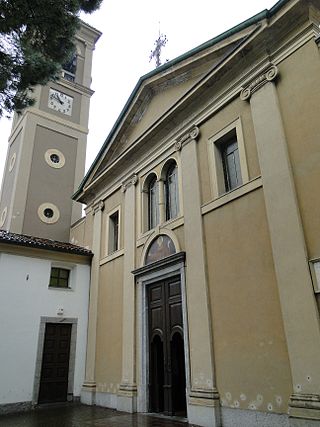Related Research Articles

Fra Bartolomeo or Bartolommeo, also known as Bartolommeo di Pagholo, Bartolommeo di San Marco, Paolo di Jacopo del Fattorino, and his original nickname Baccio della Porta, was an Italian Renaissance painter of religious subjects. He spent all his career in Florence until his mid-forties, when he travelled to work in various cities, as far south as Rome. He trained with Cosimo Rosselli and in the 1490s fell under the influence of Savonarola, which led him to become a Dominican friar in 1500, renouncing painting for several years. Typically his paintings are of static groups of figures in subjects such as the Virgin and Child with Saints.

Imola is a city and comune in the Metropolitan City of Bologna, located on the river Santerno, in the Emilia-Romagna region of northern Italy. The city is traditionally considered the western entrance to the historical region Romagna.

Mazzorbo is one of various islands in the northern part of the Lagoon of Venice. Like the other islands in this part of the lagoon, it was the site of one of the earliest settlements in the lagoon which predated the development of Venice. However, these islands then declined and were eventually abandoned. In the 1980s the architect Giancarlo De Carlo built a brightly coloured residential neighbourhood to help to repopulate Mazzorbo. In 2019 its population was 256. It is linked to Burano by a wooden bridge. It was once an important trading centre but is now known for its vineyards and orchards. Its main attraction is the fourteenth century church of Santa Caterina.

Carlo Cignani was an Italian painter. His innovative style referred to as his 'new manner' introduced a reflective, intimate mood of painting and presaged the later pictures of Guido Reni and Guercino, as well as those of Simone Cantarini. This gentle manner marked a break with the more energetic style of earlier Bolognese classicism of the Bolognese School of painting.

Corrado Giaquinto was an Italian Rococo painter.

Giuseppe Maria Crespi, nicknamed Lo Spagnuolo, was an Italian late Baroque painter of the Bolognese School. His eclectic output includes religious paintings and portraits, but he is now most famous for his genre paintings.

The Basilica of San Petronio is a minor basilica and church of the Archdiocese of Bologna located in Bologna, Emilia Romagna, northern Italy. It dominates Piazza Maggiore. The basilica is dedicated to the patron saint of the city, Saint Petronius, who was the bishop of Bologna in the fifth century. Construction began in 1390 and its main facade has remained unfinished since. The building was transferred from the city to the diocese in 1929; the basilica was finally consecrated in 1954. It has been the seat of the relics of Bologna's patron saint only since 2000; until then they were preserved in the Santo Stefano church of Bologna.

The Basilica of San Domenico is one of the major churches in Bologna, Italy. The remains of Saint Dominic, founder of the Order of Preachers (Dominicans), are buried inside the exquisite shrine Arca di San Domenico, made by Nicola Pisano and his workshop, Arnolfo di Cambio and with later additions by Niccolò dell'Arca and the young Michelangelo.

Lorenzo de Caro was an Italian painter, active in the late Baroque style in his native city of Naples.

San Fedele is a Jesuit church in Milan, northern Italy. It is dedicated to St. Fidelis of Como, patron of the Catholic diocese of Como. Presently it remains a parish church, owned by the Jesuit order, though focusing on religious works.

San Carlo al Corso is a neoclassic style, Roman Catholic church located in the Piazza of San Carlo, just off Corso Vittorio Emanuele II, just west of the Piazza San Babila, in central Milan, region of Lombardy, Italy.

The Certosa di Bologna is a former Carthusian monastery in Bologna, northern Italy, which was founded in 1334 and suppressed in 1797. In 1801 it became the city's Monumental Cemetery which would be much praised by Byron and others. In 1869 an Etruscan necropolis, which had been in use from the sixth to the third centuries BC, was discovered here.

The National Art Gallery of Bologna is a museum in Bologna, Italy. It is located in the former Saint Ignatius Jesuit novitiate of the city's University district, and inside the same building that houses the Academy of Fine Arts. The museum offers a wide collection of Emilian paintings from the 13th to the 18th century and other fundamental works by artists who were in some way related to the city.

Jacopo Zoboli, also known by Giacomo, was an Italian painter of the Baroque style.
Pietro di Bagnara or Pietro Bagnara Bacchi was an Italian monk and painter. He was born in Bagnara and studied painting is Bologna.
Santa Maria della Carità is a Renaissance-style Roman Catholic church in central Bologna, Italy.

Santi Materno e Lucia is a Roman Catholic parish church and former Convente of the Cappuccini are located on Piazza San Cristoforo in the neighborhood of Pescarenico in the town of Lecco, region of Lombardy, Italy.

The church and convent of the Santissima Annunziata is a Baroque-style, Roman Catholic church located on Piazza de Servi #4, Pistoia, region of Tuscany, Italy. The convent presently functions as a warehouse. The church is down via Laudesi from the San Desiderio, and via Piazza de Servi, From San Giovanni Decollato.

The Basilica of St. Peter Alli Marmi is a Basilica comprising a church and a monastery. It is located in Eboli, 33 kilometers away from the city of Salerno, in Italy.

The city of Vicenza is extremely rich in churches, monasteries, convents and other buildings intended for worship or religious activities, built during the seventeen centuries of Christian presence in the city.
References
- ↑ Parish of San Giuseppe Sposo official site.
- ↑ Museums of Bologna in citta metropolitana site.